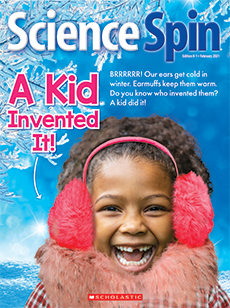September 2021
Buggy About Bugs!
Academic Standards
Reading Objective:
Children will identify steps that scientists use to conduct an investigation.
Next Generation Science Standards:
Practice 3: Planning and Carrying Out Investigations
K-LS1 Animals’ Survival Needs; 1-LS1 How Animals Use External Parts to Survive
Vocabulary: scientist, insect
Use these questions to check students’ understanding and stimulate discussion:
1. Did Dr. Sammy always like bugs?
(No. When he was 7, he was scared of bugs.)
2. What helped Sammy start to like bugs?
(He read books about bugs at the library.)
3. What did Sammy grow up to be?
(an insect scientist )
4. Which insect in the issue is your favorite? Why?
(Answers will vary.)
Go online to print or project the Reading Checkpoint.
- When Sammy was 7, he was so scared of bugs, he didn’t want to go out to recess—too many bugs!
- When Sammy turned 8, he’d grown to love bugs so much that his birthday cake had bug decorations!
- Sammy used to hate bees. Now he has a job working to protect them.
Materials: clipboards; pencils, copies of the skill sheet (optional: hand lenses)
Overview: Like Dr. Sammy, students will observe an insect in nature and record their findings. (Alternative: observe a leaf or other item from nature, or use insect photos indoors.)
Directions:
- Before you leave the classroom, tell students that scientists like Dr. Sammy observe insects to learn about them. Scientists write or draw to record what they observe.
- Give each child a clipboard, skill sheet, and pencil. Head outside.
- Look for insects in bushes, on trees, or under logs or rocks, where possible. What kinds of insects do you see? What colors are they? What are they doing? How do they move? Are they alone or in groups?
- To model scientific thinking use statements beginning with “I notice” and “I wonder.”
- Have students record their observations on the skill sheet. Back in the classroom, they can share what they observed with each other, like scientists do!
